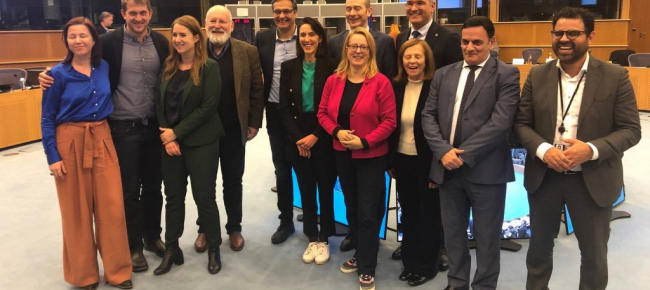Заголовок
EU agrees carbon market overhaul in bid to hit 2030 climate goalCreated date
19 12 2022European Union negotiators reached agreement early on Sunday morning (18 December) to reform the EU’s Emissions Trading Scheme (ETS), the biggest carbon market in the world and the bloc’s flagship climate policy instrument.
The ETS currently caps the emissions of around 10,000 factories and power plants, allowing those with surplus credits to make a profit by selling CO2 permits on the market.
The scheme is now being extended to cover more sectors of the economy in order to align with the EU’s 2030 climate goal – a commitment to reduce net emissions by 55% before they are eventually brought down to zero by 2050.
“This deal will provide a huge contribution towards fighting climate change,” said Peter Liese, a German lawmaker who steered negotiations on behalf of the European Parliament.
The reformed scheme “provides a clear signal to European industry that it pays off to invest in green technologies,” he added, saying the reformed EU carbon market now “covers almost all the sectors of the economy” after a decision was made to extend the scheme to maritime emissions and waste incineration.
Under today’s agreement, sectors covered by the ETS will have to cut their emissions 62% below 2005 levels by 2030 – a significant increase on the current 43% target.
“The carbon market reform is a major part of the Green Deal,” said Pascal Canfin, a French lawmaker who chairs the Parliament’s environment committee. “Thanks to the agreement reached this weekend, we will increase our industry’s climate objectives by almost 50%,” he said.
According to Canfin, “the carbon price will be around €100” after the reform, up from €80-85 currently. “No other continent in the world has such an ambitious carbon price,” he said.
A separate carbon market is also being created for buildings and road transport. This second ETS will start applying as of 2027 and will be accompanied by a social climate fund to compensate households for the extra costs this will create. And if energy prices are exceptionally high, the new scheme will be delayed by a year, until 2028.
Carbon tariff
A key flashpoint in the negotiation was to preserve the competitiveness of industries like chemicals, cement and steelmaking which currently receive most of their CO2 permits for free – an incentive to help them decarbonise and invest in green technologies.
The scheme was heavily criticised by environmental groups who said big polluters were making huge profits from the ETS without making the corresponding green investments.
Under today’s deal, free allowances will be entirely phased out by 2034 and almost cut in half by 2030 (48.5%).
They will be gradually replaced by a new carbon tariff at the EU’s border, which aims at protecting European companies from imports of cheaper products coming from countries with lower environmental standards.
The new tariff will mirror the price on the EU’s own carbon market and will initially apply to imports including iron and steel, cement, aluminium, fertilisers and electricity as well as hydrogen.
But steelmakers are wary of the EU’s new border levy, saying it won’t make pricier European steel more attractive on global markets.
The phase-out of free allocations “risks wiping out a large part of EU steel exports worth €45 billion if no concrete export solution is found before 2026” when the new carbon tariff starts applying, warned Eurofer, the European steel association.
The ETS deal also comes with extra cash for industry, including a bigger innovation fund for state-of-the-art investments in green technologies and a modernisation fund to support industries in lower-income EU countries.
In total, “nearly €50 billion will be available to support innovation and accelerate the decarbonisation of companies,” Canfin said.
And to protect EU industries from wild fluctuations in the carbon price, 24% of all ETS allowances will be placed in a market stability reserve that will release CO2 permits to cool down the market in case the carbon price gets too high.
On the European Parliament side, the deal is backed by all political groups except the far-right, Liese said, with the centre-right EPP, the left-wing S&D, the centrist Renew, the Greens and conservative ECR all supporting it.
The provisional deal now needs to be confirmed by the EU member states and the European Parliament, which will hold a plenary vote in January or February, Canfin said.
Environmental groups disappointed
WWF, the green conservation group, was critical of the deal announced this morning, saying it falls short of what is needed to keep the rise in global temperatures below 1.5°C.
“This would have been a good deal ten or twenty years ago, but in 2022 it’s too little too late,” said Alex Mason from the WWF’s European Policy Office. “To fix this and to be sure the 2030 target is met, ETS sectors should reduce their emissions by at least 70%,” the WWF said in a statement.
WWF was particularly critical of the agreement to phase out free allowances to industry, saying it the pace is “far too slow”, with a full phase out happening only in 2034.
“The free allocation of emissions allowances will be made conditional on investment in techniques to increase energy efficiency. However, if a company does not comply, it will still receive as much as 80% of its previously allocated free allowances,” the WWF remarked.
CAN Europe, another NGO, echoed those criticisms but also welcomed moves by lawmakers making it obligatory for EU governments to earmark 100% of their carbon market auction revenues for climate-friendly investments.
“EU countries will now have to spend all their ETS cash on climate action, and this is definitely a step forward,” agreed Romain Laugier from WWF. “Unfortunately, the quality of a ‘climate action spending’ is still entirely up to Member States. It means they could continue as before, and use some of this money to subsidise fossil coal and gas,” he said.
Green lawmaker Michael Bloss defended the agreement, saying it will incentivise investments in green technologies.
“The free pollution party is over, we are sending the industry on the modernisation course,” Bloss said, reminding that free allowances will be almost halved by 2030 and completely eliminated by 2034.
“The worst polluters pay extra and those who decarbonise are supported,” the German Green MEP said.















